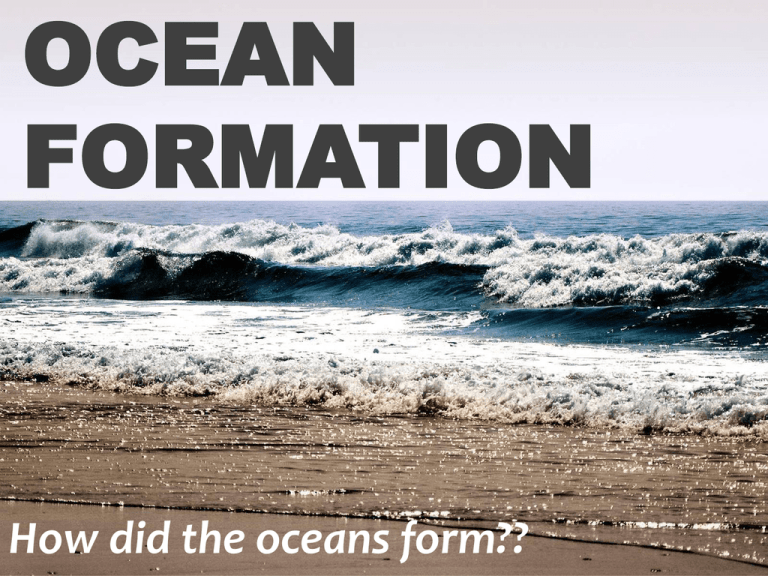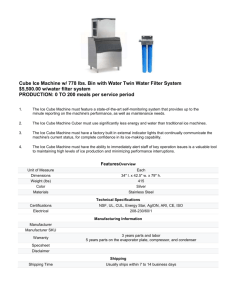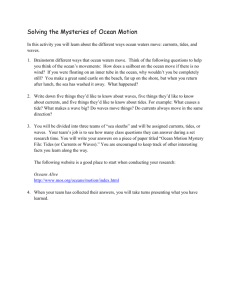Oceans formation and motion
advertisement

OCEAN FORMATION How did the oceans form?? Early Earth Discussion: • Earth is approximately 4.6 Billion Years Old • Earth is a closed system with water never leaving our planet. • So how did we get water on Earth? Formation of Oceans Notes: Early Earth was too hot for oceans. Consisted of molten rock. As Earth cooled over time, the surface solidified (hardened). Oceans formed 2 possible ways: – Comets – Volcanism Volcanism: Notes: Volcanic eruptions brought magma and gases to the surface through a process called outgassing. Gases: • Water Vapor • Sulfur Dioxide • Carbon Dioxide The water vapor condensed and this was Earth’s first liquid water. Comets and Asteroids: Notes: • More water vapor came from asteroids and comets that crashed into Earth than volcanoes. • Comets hit the Earth and released water the water filled the ocean basins over geologic time. MOTION OF THE OCEAN TYPES: Deep Water Affected by: - Density convection currents - Temp and salinity Temperature When water cools, it contracts and the water molecules move closer together. This contraction makes he water denser and sinks. When it expands, the molecules move farther apart making it less dense and rise to the top. Salinity When water freezes the salt in the water does not freeze but stays in the unfrozen water. The dense polar water sinks and begins the deep water currents. ICE CUBE LAB As the ice cube melts, the cold melt water from the ice cube sinks to the bottom of the cup forcing the water from the bottom of the cup to move toward the surface which transfers its heat to the ice cube, causing it to melt faster. Freshwater Cup ICE CUBE LAB Meanwhile in the saltwater, the cold freshwater from the ice cube floats on top of the saltwater. Thus the ice cube sits in a pool of cold water, blocking the heat from the saltwater from getting to the ice cube. Salt Water Cup ICE CUBE LAB Why is this important: - It demonstrates the layers of the ocean. - It demonstrates deep water ocean circulation with convection currents UPWELLING Upwelling - deep ocean water rises to the surface. Strong winds blow surface water away from shore that allows deeper water to flow to the surface and take its place. An upwelling occurs when deep ocean water rises to the surface. When water comes up from the deep, it brings a lot of nutrients with it. That’s because nutrients settle to the bottom over time. The nutrients brought to the surface support many living things. TYPES: Surface Water Affected by: - Air currents - Waves - Earth’s rotation - Coriolis effect - Location of the continents - Tides - Seismic Activity - Tsunamis Waves Most ocean waves are caused by winds. A wave is the transfer of energy through matter. Ocean waves transfer energy from wind through water. https://www.youtube.com/watch?v=7yPTa8qi 5X8 https://www.youtube.com/watch?v=DsSiMIYi aUc The energy of a wave may travel for thousands of miles. However, the water itself moves very little. Tides Tides are changes in the rise and fall of sea level caused by the gravitational pull of the Moon and Sun. They occur all around the globe. High tides occur when the water reaches its highest level. https://www.youtube.com/watch?v=DsSiMIYi aUc Low tides occur when the water reaches its lowest level. Coriolis Effect The Coriolis effect describes how Earth’s rotation deflects winds and surface ocean currents. Coriolis causes freely moving objects to appear to move to the right in the Northern Hemisphere and to the left in the Southern Hemisphere. The objects themselves are actually moving straight, but the Earth is rotating beneath them, so they seem to bend or curve. http://video.mit.edu/watch/the-corioliseffect-4407/ https://www.youtube.com/watch?v=_sayCU1 TNyg





